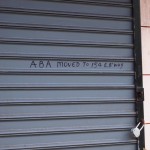
I recently had the pleasure of testing the Olympus EPL-1 that is being so highly raved about while on an excursion in Chinatown. While this is a camera that people stepping up to interchangable lens cameras might appreciate, I don’t think I ever want to touch one again. There are flaws with the camera that I really wasn’t satisfied with in addition to huge problems that are totally unacceptable. My conclusions are after the jump.
Disclaimer
Before you read this please keep the following in mind: I’m a former Olympus user. I loved Marie (my Olympus E-510 very much) but switch to Canon when my demands became greater in order to keep up with the industry. Vince owns Marie now, so I have loads of experience with Olympus products. I think that Micro Four Thirds is an absolutely wonderful thing and thank Olympus for being the first to make such small and good quality cameras. I was very pleased with the EP-2 and felt that the EP-1 was more of a beta product to excite the world than anything else. I walked around with it at Photo Plus and didn’t like it very much.
If I had sell all my Canon gear and go to Micro Four Thirds, I would choose the Panasonic GH-1 and the Olympus EP-2. However, I do feel that Micro Four Thirds needs to aim some of their cameras more towards the professional market as the economy proves that we are the ones that will most likely spend the money for something like that. Granted though, entry-level DSLR cameras are found in the hands of many people in NYC now.
The following field test proves that Olympus headed a step in the opposite direction. A personal preference of mine goes more towards Panasonic’s line of cameras. However, I do feel that the entire Micro Four Thirds system needs to stop competing with themselves and other manufacturers and instead unite together to take on the likes of Canon, Nikon and Sony. If they do, wonderful and game changing things will happen.
Also please note that I am not even putting a link over the B&H for my readers to purchase the camera if they please. The reason for doing this is because I do not feel that my audience will enjoy this camera as I truthfully haven’t. My audience is comprised of advanced hobbyists/enthusiasts, photography students, semi-professionals and high end professionals. This camera is designed for the photography illiterate person. Granted, my website does teach said audience to become more knowledgeable about photography and cameras, the EPL-1 is still not a camera that I feel ThePhoblographer’s audience will appreciate. Though you may call me biased on this, I invite you to come shooting with me one day in NYC if you can get one if your hands and you will see and experience the same problems that I have faced.
Ergonomics
The EPL-1’s ergonomics are horrible. I remember telling this to my companion that loaned it to me while shooting. To be fair, they’re horrible to me. The grip on this camera is very, very uncomfortable. To counter this, the camera is actually easier to hold like an actual point-and-shoot. Only then does it become comfortable in the hands. If such is the case though, the grip wasn’t needed at all. At least, it doesn’t have to be jutting out this much to the point of being obnoxious.
The scroll wheels that we were used to on the EP-1 and EP-2 are gone. Buttons instead replace them: this is something you typically find on more point and shoots. I miss my wheels as they allowed for easier image manipulation on the fly. The layout of the buttons though is quite logical, I’ll give them that.
Granted, I’ve studied and discussed the shooting habits of the target audience that this camera is aimed at. Most of those people will leave it in auto and just shoot. Therefore, they’ll largely ignore all the buttons and some of the features that the engineers worked hard on like slow-motion (which is essentially shutter speed).
When you hold it by the grip, it almost feels like an entry-level DSLR or rangefinder. To that end, I kept bringing it up to my eye to shoot, only to be disappointed that I didn’t have the viewfinder eyepiece.
Autofocus
Unacceptably slow, but it is accurate with stagnant objects. I spent most of the time shooting in Aperture and iAuto mode. If you want to track a moving object, you’re going to need to manipulate the settings yourself as the EPL-1 cannot keep up with anything that moves. That’s a real dealbreaker for people that want to take pictures of their kids or dog.
What hurts even more is that for around the same price, you can get an entry level DSLR that can track moving object much better.
To be fair, these are two different autofocus systems. If I handed this camera off to one of my students, I’d tell them to just use manual focus and use the rules of the hyperfocal length when it comes to shooting.
Art Filters
I tested out the grainy b&w, tilt shift and pop art filters. The latter delivers some really lovely results. Grainy b&w does not look like old time film: it looks like a terrible photoshop job. Tilt shit could have been done much better. I’ve seen great results on the other cameras, but this one disappoints. Additionally, it takes forever to process the image.
Image Quality
[youtube=https://www.youtube.com/watch?v=Z-XMJCQTGh4]
All images were shot with the kit lens. I’ve been able to do some spectacular things with kit lenses before when I was starting out as a photographer and this one really isn’t up to par with competing lenses. However, it is quite sharp. All images were shot in JPEG mode and not RAW. Had they been shot in RAW, I’m positive that I would’ve had different results. To be fair, you can say that with any camera that shoots in RAW and most people that use this camera may not use RAW at all. Lots of DSLR users around NYC don’t.
The best images from this camera are, believe it or not, come from the video mode. If I wanted to replace my camcorder, I would use this instead. However, I’ve got a 5D Mk II and a 7D.
Discreteness
This is probably where I felt that the EPL-1’s strengths really shined. It looks like a large point and shoot and so no one was intimidated by the camera when I shot with it vs using a giant DSLR. The shutter is also pretty quite, though not as pleasing to the ear as the EP-2’s or EP-1’s.
Conclusions
Would I buy this camera? No. Would I recommend it? Not really. Canon, Pentax and Sony offer some really amazing entry level DSLRs. For the price point, there is better out there. I would actually tell people of this audience to go buy a used EP-1 instead. My hope is that the EPL-2 actually is targeted more towards beginners and that Olympus also doesn’t try to target advanced users as well. They should keep the EP-2/EP-1 line for the advanced and professionals and the EPL-1 for real beginners. Therefore, why not go right ahead and take off the manual modes? You could also throw in more consumer-like features as well, like integrated GPS and even go the Panasonic route with a touchscreen.
While I didn’t spend nearly as much time with the EPL-1 that I did with other cameras for review, I can tell you that it is something that would take this photographer a while to get used to.
Edit: something I forgot to talk about was the battery and power saving methods. After a couple of minutes of not using the camera, it shuts off. Not goes to sleep, shuts off. This will annoy the typical person that will buy this camera and they won’t even bother to scroll through the menus to fix this problem.


























